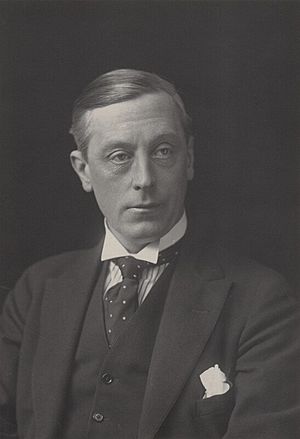Arthur Greenwood facts for kids
Quick facts for kids
Arthur Greenwood
|
|
|---|---|

Greenwood in 1924
|
|
| Paymaster General | |
| In office 9 July 1946 – 5 March 1947 |
|
| Prime Minister | Clement Attlee |
| Preceded by | Frederick Lindemann |
| Succeeded by | Hilary Marquand |
| Lord Keeper of the Privy Seal | |
| In office 27 July 1945 – 17 April 1947 |
|
| Prime Minister | Clement Attlee |
| Preceded by | Max Aitken |
| Succeeded by | Philip Inman |
| Minister without Portfolio | |
| In office 17 April 1947 – 29 September 1947 |
|
| Prime Minister | Clement Attlee |
| Preceded by | A. V. Alexander |
| Succeeded by | Geoffrey FitzClarence |
| In office 11 May 1940 – 22 February 1942 |
|
| Prime Minister | Winston Churchill |
| Preceded by | Maurice Hankey |
| Succeeded by | William Jowitt |
| Leader of the Opposition | |
| In office February 1942 – 23 May 1945 |
|
| Prime Minister | Winston Churchill |
| Preceded by | Frederick Pethick-Lawrence |
| Succeeded by | Clement Attlee |
| Deputy Leader of the Labour Party | |
| In office 26 November 1935 – 25 May 1945 |
|
| Leader | Clement Attlee |
| Preceded by | Clement Attlee |
| Succeeded by | Herbert Morrison |
| Minister of Health | |
| In office 7 June 1929 – 24 August 1931 |
|
| Prime Minister | Ramsay MacDonald |
| Preceded by | Neville Chamberlain |
| Succeeded by | Neville Chamberlain |
| Member of Parliament for Wakefield |
|
| In office 21 April 1932 – 9 June 1954 |
|
| Preceded by | George Brown Hillman |
| Succeeded by | Arthur Creech Jones |
| Member of Parliament for Nelson and Colne |
|
| In office 15 November 1922 – 7 October 1931 |
|
| Preceded by | Robinson Graham |
| Succeeded by | Linton Thorp |
| Personal details | |
| Born | 8 February 1880 Hunslet, Leeds, England |
| Died | 9 June 1954 (aged 74) London, England |
| Political party | Labour |
| Spouse | Catherine Ainsworth |
| Children | 2, including Tony |
Arthur Greenwood CH (born February 8, 1880 – died June 9, 1954) was an important British politician. He was a leading member of the Labour Party for many years, from the 1920s to the late 1940s. He is especially remembered for helping Britain decide to keep fighting Nazi Germany during World War II in 1940.
Contents
Growing Up
Arthur Greenwood was born in Hunslet, a town near Leeds, England. His father was a painter and decorator. Arthur went to Yorkshire College, which is now the University of Leeds. He studied science there.
Political Career
Becoming a Politician
Arthur Greenwood first became a Member of Parliament (MP) in 1922. He represented the area of Nelson and Colne in Lancashire. He lost his seat in 1931 but returned to Parliament the next year. He won a special election in Wakefield, Yorkshire. Greenwood continued to be the MP for Wakefield until he passed away in 1954.
Helping the Country
In 1929, Greenwood became the Minister of Health. He held this job until the Labour government ended in 1931. During his time as Health Minister, he helped increase pensions for widows. He also passed the Housing Act 1930, which helped clear out old, unhealthy housing areas (called slums).
Greenwood later became the Deputy Leader of the Labour Party. This was under the leadership of Clement Attlee.
A Famous Moment in History
On September 2, 1939, World War II had just begun. The Prime Minister, Neville Chamberlain, gave a speech that seemed unsure about whether Britain would help Poland. Arthur Greenwood had to respond because Clement Attlee was ill.
Just as he was about to speak, a Conservative MP, Leo Amery, shouted, "Speak for England, Arthur!" This moment became very famous. Greenwood then gave a strong speech. He said he was "gravely disturbed" by the delay in acting. He reminded everyone that a treaty had been broken and that "human civilisation" was in danger. His words helped convince many that Britain needed to act decisively.
During World War II
When a special government was formed during the war, Winston Churchill made Greenwood a Minister without Portfolio in 1940. This meant he was a minister without a specific department. He wasn't always seen as very effective. However, in May 1940, he played a crucial role. During important meetings, he strongly supported Churchill's decision to keep fighting Germany. Without his vote and Clement Attlee's, Churchill might not have had enough support to continue the war.
After this, his influence lessened, and he left his role in 1943. He also became the Treasurer of the Labour Party that same year. From 1942 until the end of the war, Greenwood also acted as the Leader of the Opposition.
After the War
When the Labour government led by Clement Attlee came to power after the war, Arthur Greenwood served in important roles. He was the Lord Privy Seal and later the Paymaster General.
Death
Arthur Greenwood passed away on June 9, 1954, in London. He was cremated, and his ashes are at Golders Green Crematorium.
Family
Arthur Greenwood's son, Anthony Greenwood, also became a Member of Parliament. He served from 1946 to 1970 and was part of Harold Wilson's governments.

